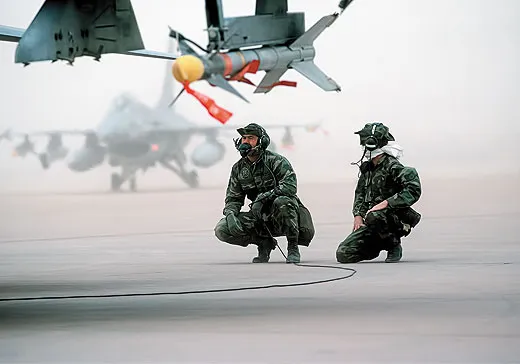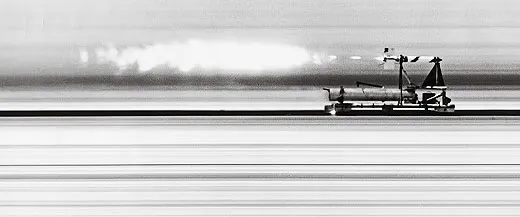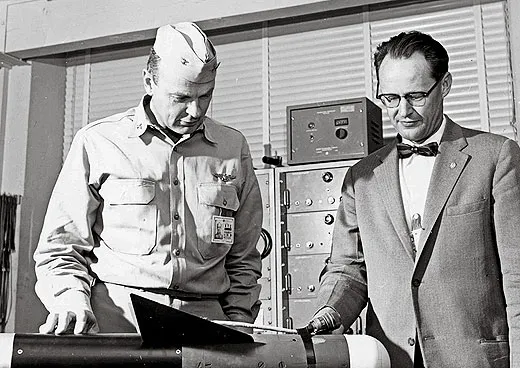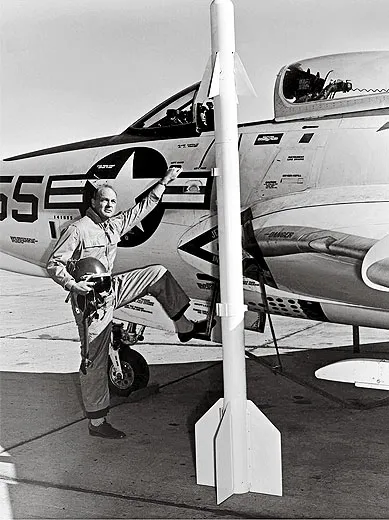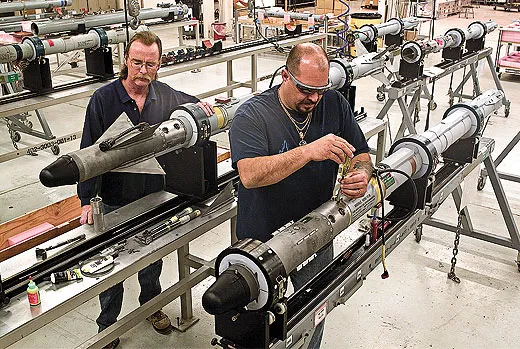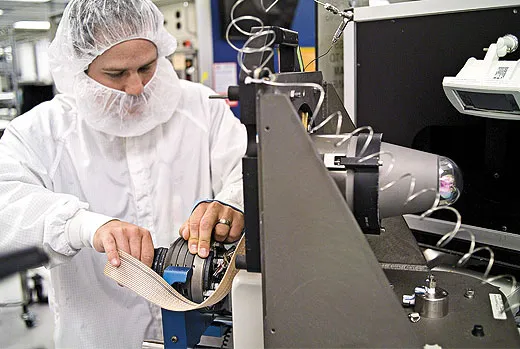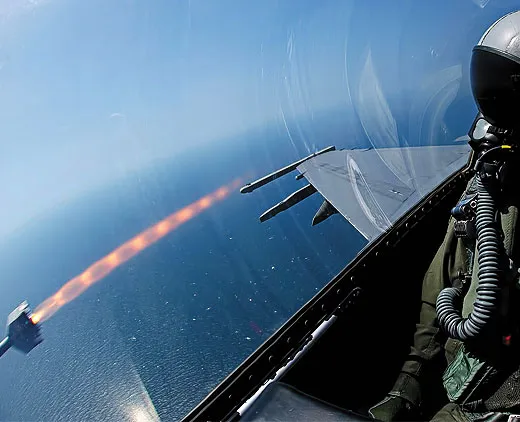Sidewinder
The missile that has rattled enemy pilots since 1958
/https://tf-cmsv2-smithsonianmag-media.s3.amazonaws.com/filer/Sidewinder_8_FLASH.jpg)
May 1956. Holloman Air Force Base, Alamogordo, New Mexico. The preflight briefing took place in the office of the base’s commanding general, but the center of attention was a cocky young Navy pilot named Glenn Tierney. He was dead certain that he was about to win a shoot-off between two weapons competing to become the United States’ first self-guided air-to-air missile. The Air Force was betting on the radar-guided Falcon, built by a vast engineering group at Hughes Aircraft. Representing the Navy, Tierney was betting on the heat-seeking Sidewinder, developed by a small cadre at the Naval Ordnance Test Station in China Lake, California.
Tierney, the commander of Guided Missile Unit 61, had already demonstrated the lethality of the Sidewinder, blowing up a surface-to-surface Matador missile a few hours earlier. Now, he told his skeptical audience, he planned to fly as a wingman while an Air Force pilot who had never before fired a Sidewinder destroyed a second Matador. When the general scoffed, Tierney told him, “I’ll cover all the bets in the room up to $100.”
After $85 was collected, Tierney and an Air Force lieutenant took off in a pair of F-100 Super Sabres. At 30,000 feet and Mach 0.8, they lined up two miles behind a Matador already in the air. “You got signal?” he radioed to the other pilot.
“I got good signal,” said the pilot, referring to the distinctive growl in his headset, which meant that the heat-seeker in the nose of his Sidewinder had locked onto the infrared radiation of the Matador’s exhaust.
“Well, let her go,” said Tierney.
“It was a turkey shoot—nothing to it,” Tierney recalls with a chuckle. “The Sidewinder blew that son of a bitch right out of the sky.” Tierney flew back to China Lake with $85 of Air Force money in his wallet.
Despite the Sidewinder’s success at Holloman, the Air Force chose to put its own missile, the Falcon, into service in 1956. The missile was so finicky that in Vietnam, it became synonymous with failure. The Sidewinder, on the other hand, which entered service in the Navy a few months after the Falcon, scored the world’s first guided-missile kill: a Chinese MiG-17 that a Taiwanese F-86 shot down in 1958. Since then, the Sidewinder, later designated the AIM-9 (for Air Intercept Missile), has claimed dozens of victims in Vietnam, several Arab-Israeli conflicts, the Falkland Islands War, and Operation Desert Storm.
The missile has been built by the hundred thousands not only in the United States but also under license in several NATO countries. Working with stolen plans, the Soviets copied it so faithfully that the Vympel K-13 shared the Sidewinder’s parts numbers. The Soviet missile was exported en masse to Warsaw Pact countries and later copied by the Chinese. But new-and-improved ’Winders continue to be assembled by Raytheon in Tucson, Arizona, and the missile has progressed through the alphabet from the AIM-9A to today’s AIM-9X.
Even after all these years, the latest Sidewinder variant still retains the five-inch diameter and rough dimensions of the cigar-shaped original. It’s gotten longer (from just over 109 to 119 inches) and leaner, from 155 pounds to 118 pounds. But like George Washington’s hatchet (“Only the handle and the blade have been replaced”), the Sidewinder has been modified so thoroughly over the past half-century that just about all that remains of the original is the name. Well, that and the fundamental concept, which dates back to 1947, when an engineering genius named Bill McLean made a rough sketch of what he called a “target-seeking gyro.” A few years later, he filed a patent application for a “heat homing rocket.” By the time McLean and his merry band of missileers at China Lake were finished, the Sidewinder had earned a spot on the short list of weapons that have changed the way battles are fought.
After World War II, the Naval Ordnance Test Station at China Lake (now the Naval Air Warfare Center Weapons Division) was the Promised Land for weapons development and testing. Situated in the Mojave Desert three hours northeast of Los Angeles, it featured 1,200 square miles of largely unpopulated terrain that was perfect for blowing things up. Its remote location also fostered a self-reliant spirit and contrarian mentality that attracted unconventional thinkers. McLean, a graduate of the California Institute of Technology whose genial and unassuming demeanor hid a mighty intellect (later Sidewinder program manager Frank Cartwright describes him as “a 108 on a scale of 100”), arrived in 1945 to work on air-to-air rockets.
Rockets serve a lot of useful functions, but shooting down airplanes isn’t one of them, a truth demonstrated all too clearly in 1956, when a pair of F-89 Scorpions fired 208 rockets against a wayward drone that was threatening southern California, and failed to score a single hit. After World War II, various military contractors developed nearly a dozen guided missiles. The most promising guidance system seemed to be radar, which was, after all, a proven technology. But because the equipment was too bulky to fit inside a rocket, the airplane firing the missile had to “paint” the target with radar, and the pilots had to stay locked on until the warhead detonated.
McLean had a better idea: Why not create a weapon that carried its own control system, so the missile was guided by the target? This led him to investigate the use of an infrared seeker to detect the target’s heat. McLean wanted to give a conventional rocket—a dumb weapon—eyes and a brain. The missile would “see” via a transparent seeker head, through which infrared radiation from the exhaust of a jet engine would reflect off a gimballed, rotating mirror onto a lead-sulfide photocell. As the gyroscopically stabilized mirror moved to track the heat source, a servo motor manipulated the canards that controlled the missile’s flight, maintaining a constant bearing with respect to the target. Proportional navigation, as the technique is called, enabled the missile to anticipate where the target was going to be rather than aiming at where it was, like a quarterback leading a receiver.
Compared with radar-guided missiles, McLean’s alternative was cheap, simple, and robust. Also, unlike radar guidance, it was a passive weapon that gave the targeted pilot no warning until he saw the missile flying toward him. Small, lethal, and able to strike quickly and outmaneuver its quarry, it shared several qualities with another heat-seeking predator native to the Mojave Desert: the sidewinder rattlesnake. So in 1950, another proposed name—Low I.Q. Homing Head—was rejected, and Sidewinder was adopted.
There was no official backing for the project, and on several occasions it was nearly canceled. But the tiny team working on the Sidewinder was persistent as well as ingenious, and the engineers, faced with seemingly intractable problems, developed a host of elegant solutions. A good example was the so-called rollerons: spur-like discs that unlocked from the tail fins in flight. The gyroscopic effect of the spinning discs prevented the missile from rotating on its axis. And then there was the famous Sidewinder tone, a menacing growl—once heard, it is never forgotten. During early flights, test pilots had to check a small voltmeter in the cockpit to determine whether the seeker was sensing a heat source, an unwanted distraction in the middle of a dogfight. By running an additional wire to the missile, the Sidewinder team was able to create a sound that could be piped into pilots’ headsets to alert them that the seeker had acquired a target.
Tom Amlie worked on the Sidewinder project as a young Navy lieutenant, and he later became technical director at China Lake. He says the secret of the missile’s success is simplicity: “In flight, it had seven vacuum tubes and five moving parts. The competition [Falcon] was complicated almost beyond description.” For professor Ron Westrum, the author of Sidewinder: Creative Missile Development at China Lake, the project demonstrated the triumph of lean R&D and imaginative management. “They had less than 25 people in the beginning, and they did it as a bootleg project,” he says. “The Sidewinder demonstrated that what we now call a skunk works actually works.”
Well, not at first.
Several years of development passed before the missile was ready to be fired in a simulated combat environment. In August 1952, astronaut-to-be Wally Schirra, flying an AD-4 Skyraider, launched a heat-seeker toward a propeller-driven Grumman F6F Hellcat that had been turned into a radio-controlled drone. Final score: Hellcat 1, Sidewinder 0. In fact, all 12 of the first Sidewinders missed the target. On several tests, Amlie flew in the right seat of the attack aircraft. After one failure, he wrote a memo quoted by Elizabeth Babcock in her history of China Lake, Magnificent Mavericks: “Missile took off like a big-assed bird, never saw it again.”
The 13th test, on September 11, 1953, was the charm. The Sidewinder fired by Lieutenant Commander Al Yesensky missed the drone by two feet, but if the missile had been equipped with a warhead and a proximity fuse, it would have destroyed the Hellcat, so the shot was declared a success. Four months later, an unarmed Sidewinder scored its first direct hit, punching a hole through the number 1 engine of a QB-17 drone. Then, on February 17, 1954, the Sidewinder did the unthinkable: It brought down—in cartwheeling flames—another QB-17 thought to be indestructible because it had survived so many missile attacks over the years.
The Sidewinder had shown its fangs.
CONVENTIONAL MILITARY WISDOM circa 1967 held that close-in dogfights were a relic of the past. Radar-guided AIM-7 Sparrows, developed by Sperry Gyroscope and Douglas Aircraft and first deployed in 1958, were supposed to take out bogeys while they were still miles away, and if that didn’t work, AIM-9 Sidewinders would finish the job long before enemy pilots got close enough to fire cannon. Thus, the F-4B Phantom wasn’t even equipped with a gun. Which meant that Navy Lieutenant Denny Wisely couldn’t do anything other than give his North Vietnamese adversary the finger as they passed canopy to canopy in the airspace near Hanoi.
The date was April 24, 1967, and Wisely was embroiled in an epic furball: three F-4s against eight or nine MiG-17s. Twice, he was in position to fire the gun he didn’t have. Compounding the problem, his Phantom had been loaded with only one Sidewinder instead of the usual four (a fast turnaround of the aircraft between missions didn’t leave enough time for ground crews to install the full ordnance load). He was carrying four Sparrows, but he figured he was too close to the nimble MiGs to use the long-range missiles.
“We’re not going to get radar lock in this environment,” Wisely recalls radioing his backseater, Lieutenant (junior grade) Gary Anderson. “I’ll just keep pulling the airplane up, using the afterburner as necessary, then unloading it and turning so you can reach around in your seat and really check our six.”
Zooming up and down between the treetops and 5,000 feet, Wisely waited for the right shot for his single Sidewinder. Twice, he saw Sparrows punched off by other Phantoms fly harmlessly into the distance. Then he spotted a MiG sidling in behind an F-4. Wisely rushed in behind it, heard his Sidewinder growling, and fired. Another North Vietnamese pilot must have alerted Wisely’s prey. But as the MiG banked right to escape the missile, the ’Winder struck and exploded.
“It was just ‘Thank you very much, MiG,’ ” Wisely says today.
Wisely’s experience notwithstanding, guided missiles performed much worse in Vietnam than expected. Sparrow hit rates through 1968 were so anemic—eight percent—that most pilots fired them in pairs, figuring at least one would be a dud. With a hit rate of 16 percent, the Sidewinder was twice as good but not nearly good enough. Actually, the Navy version of the Sidewinder, the AIM-9D, had a nitrogen-cooled seeker head that improved its ability to track infrared radiation, enabling it to outperform the Sidewinders used by the Air Force. Nevertheless, the Navy was so upset that it commissioned a hard-driving captain named Frank Ault to figure out what was wrong.
After several months of study, Ault produced a 480-page Air-to-Air Missile System Capability Review. Popularly known as the Ault Report, it began by assessing what happened when 600 air-to-air missiles were fired in 360 Navy and Air Force combat engagements between 1965 and 1968. “Only about one in ten had any probability of achieving a kill,” the report stated. To hit its target, the Sidewinder had to be launched within a strictly defined envelope, no more than roughly 30 degrees off the tail of the adversary and at relatively modest G loading. Among his 242 recommendations, Ault suggested that the Navy create a school for post-graduate air-to-air combat training. In 1969, the Navy Fighter Weapons School, a.k.a. Topgun, was established at then Naval Air Station Miramar in California.
“Most dogfighting maneuvers, from World War I to Vietnam, were designed to put a fighter in a gun’s firing envelope,” says Robert Shaw, an author and air combat consultant who used to fly a gunless Navy F-4. “But with the Sidewinder, once you got into gun range, you were too close to fire.” Since airplanes were so much farther apart, turning with the enemy made no sense, so counterintuitive tactics—flying vertically when the target turned horizontally, for example—were developed. Also, the conventional fighting, or welded, wing, in which the leader hunts for targets while his wingman protects his rear, didn’t work in the missile environment. Instead, Shaw explains, aircraft moved farther apart and flew line abreast so that each could watch the other’s tail.
As tactics improved, so did the Sidewinder. Over the years, it underwent a series of upgrades—better seekers, more efficient fuses, stouter rocket motors, slicker aerodynamics—to expand the firing envelope and make the missile less susceptible to countermeasures. The AIM-9L added all-aspect capability—it could hit an airplane no matter what its relative angle, even approaching head on. This so-called Super Sidewinder was so deadly that in dogfights over Lebanon and during the 1982 Falkland Islands War, it posted kill ratios of better than 80 percent. And in the next decade the follow-on, AIM-9M, was even more efficient in dogfights over Iraq and Bosnia.
But by the mid-1990s, the Sidewinder seemed on the verge of being replaced by newer heat-seeking missiles with more bells and whistles. Instead, a digital makeover gave engineers the chance to “teach an old dog new tricks,” as Dave S. Adams, director of Raytheon’s short-range-missile programs, puts it. In the fifth generation AIM-9X, the analog seeker and its mechanically rotating mirror—what Adams calls a “chirps and squeaks system”—were replaced with a staring focal plane array, the pixel-based technology in a digital camera. Besides being able to track infrared energy more efficiently and see targets more accurately through its nose cone, the latest AIM-9X is also far better at distinguishing between targets and countermeasures, such as flares.
At the tail end of the missile, designers added movable jet vanes to redirect the exhaust plume of the motor and achieve a form of thrust vectoring. This allows the -9X to turn at much sharper angles after coming off the launch rail than previous models, which is a major advantage in close-in aerial combat—the proverbial knife fight in a phone booth. And by using thrust vectoring to help control the missile, designers could reduce the size of the Sidewinder’s conventional control surfaces—canards and tail fins—and clean up the missile’s aerodynamic profile. So despite using the same solid-fuel rocket motor as the -9M, the -9X flies significantly faster and farther.
MARCH 1991. The war with Iraq was over, but the cease-fire was still in place, and Captain Tom Dietz and his wingman, Lieutenant Bob Hehemann, were patrolling the skies 50 miles north of Baghdad in their Air Force F-15 Eagles. During the fighting, they’d used Sidewinders to down four Iraqi jets making a run for the Iranian border. But according to the rules of engagement in force since the cease-fire, the Iraqis were allowed to fly helicopters. So when Dietz locked up a pair of targets on his radar scope, he assumed that’s what they were—until he realized that they seemed to be flying at 345 mph. “Let’s go investigate this,” he radioed Hehemann.
They pushed their throttles forward to military power. At a range of about five miles, Dietz started to make out the details of one bogey: Canopy. Sloped tail. Swept wings. Suddenly, his radio crackled: “VID Fitter.” Hehemann was visually identifying the Iraqi aircraft as a Sukhoi Su-22 fighter-bomber (“Fitter” is the Su-22’s NATO name). They would later learn that it was returning from a mission to bomb Kurdish civilians. Dietz, closing quickly, immediately activated the master switch, which cooled the seeker head of his Sidewinder by flooding it with argon gas. A second or two later, he uncaged the missile, got a good tone, and fired.
“I didn’t want to fly out in front of the Fitter,” Dietz recalls. “So I pulled up as soon as I saw the missile come off the rail. When I rolled back over and looked down, all I saw was a fireball. The AIM-9 went right up this guy’s tailpipe, and his airplane blew up just like the movies. There was not a discernible piece left, just a bunch of metal in a huge fireball.”
Since Desert Storm ended, the world has changed radically, and nobody knows what the combat environment will look like if and when airplanes trade ordnance again. In the future, some military thinkers suggest, aerial engagements may feature more unmanned vehicles than conventional fighters, and the diminishment of the human factor could change the calculus of weapon design. At the same time, history has taught us that each advance in military technology expands the weapon-engagement zone, from ancient swords with a range of only a few feet to beyond-visual-range missiles that can destroy targets seen only on radar screens.
Under the circumstances, says Dik Daso, a former Air Force F-15 pilot who is now the National Air and Space Museum’s curator for modern military aircraft, the role of the Sidewinder is bound to shrink. “These days,” he explains, “the object is to deploy your radar missiles so that when you get to the merge [the point at which two fighters pass each other], hopefully you see nothing but fireballs. But in air-to-air combat, nothing ever goes perfectly, and I think the AIM-9 is the best fallback for self-defense that you can have.” Says Captain Jeffrey Penfield, a former F/A-18 pilot who, until recently, ran the Navy’s Air-to-Air Missile Program Office: “When you get in a mano-a-mano, visual-versus-visual engagement, the AIM-9 is the weapon of choice.”
Military procurement officials apparently agree. Since 2001, more than 4,000 AIM-9Xs have been built, and the missiles have been sold to 10 countries, bringing the total production to more than 200,000 Sidewinders flown by 51 nations during the past half-century. An upgraded Block II version is poised to start coming off the assembly line in Tucson (in the cavernous plant that Howard Hughes erected to build the Sidewinder’s original rival, the Falcon). Current plans call for production to continue into the 2020s. It should come as no surprise that there’s talk of certifying the AIM-9X for the next-gen F-22 and F-35 fighters. In fact, unless some new technology (lasers? directed-energy projectiles? space-time-continuum shredders?) renders heat-seeking missiles obsolete, AIM-9s will likely still be in military inventories a century after the first successful launch at China Lake.
This time around, nobody’s betting against the Sidewinder.
Frequent contributor Preston Lerner wrote “Black Day at White Sands,” a look back at the McDonnell Douglas DC-X, for the August 2010 issue.
